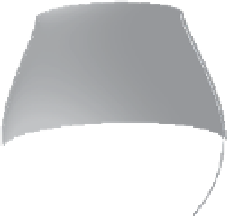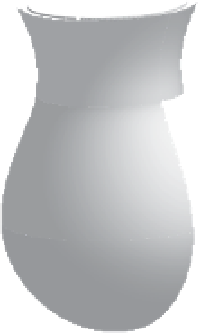Graphics Reference
In-Depth Information
once, enabling so-called
one-shot scanning
(Section
8.2.3
). Finally, we discuss struc-
tured light systems targeted at capturing dynamic scenes in real time using
fringe
projection
(Section
8.2.4
).
8.2.1
Calibration
The earliest range scanners used a visible-spectrum laser passing through a cylindri-
cal lens to cast a strong, bright stripe on the object to be scanned, and this technique
is still used today (e.g., for the scanners pictured in Figure
8.9
). The key problem is to
determine the geometric relationship between each plane of laser light and the cam-
era's image plane, as illustrated in Figure
8.11
. As we'll see, this process is very much
like calibrating two cameras, except that one of the cameras is replaced by a laser.
As we know from Sections
5.1
and
6.3.2
, the relationship between the coordinates
of two 3D planes is given by a 2D
projective transformation
. We assume that the
plane of laser light has world coordinates given by
(
)
=
X
,
Y
,
Z
with
Z
0, so that the
(
)
coordinates of the plane are given by
X
,
Y
and we have
∼
X
Y
1
h
11
h
12
h
13
h
21
h
22
h
23
h
31
h
32
h
33
x
y
1
(8.4)
where the image plane coordinates of the camera are given by
. Here, we've
represented the 2D quantities as homogeneous coordinates and the projective
transformation as a 3
(
x
,
y
)
×
3 matrix
H
defined up to scale.
Y
X
y
Z
x
Laser
Camera
Figure 8.11.
The image plane of the camera (with coordinates
(
x
,
y
)
) and the plane of laser
light (with coordinates
(
X
,
Y
)
). The two 2D coordinate systems are related by a projective
transformation.

















































































































































































